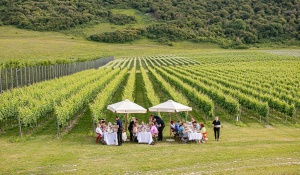Sussex granted PDO status, further boosting English wine

English wine continues to go from strength to strength, with wine produced in Sussex today being granted Protected Designation of Origin (PDO) status, giving it the same legal footing as Jersey Royal potatoes, Cornish clotted cream and Stilton cheese.
The PDO also emphasises the importance of terroir in English winemaking by differentiating wines made in Sussex from those made elsewhere.
This comes as a victory for winemakers including Rathfinny, Ridgeview and Bolney, who have been battling to turn Sussex into a recognised appellation since 2015.
"The approval of a PDO for wines grown and made in Sussex comes at an important time for English and Welsh wines,” said Simon Thorpe MW and chief executive WineGB. “There has never been more interest in and demand for our wines and the reputation they have gained in both domestic and international markets is based on high-quality viticulture and winemaking excellence."
Mark Driver, the former hedge fund manager who set up Rathfinny Wine Estate, told Harpers: "We can’t wait for the day when you can go into a bar in London, New York, Beijing, or Tokyo and will be asked: would you like a glass of Champagne or a delicious glass of Sussex?"
However, not everyone is quite so happy with the new designation, with one winemaker describing it as a “joke” and a “marketing exercise”.
Graham Barbour, founder and owner of Woodchurch Wine Estate in neighbouring Kent, told the Telegraph: “This is just a marketing exercise based on the political boundaries of a county. It tells you nothing about the geographical features of a particular vineyard or the quality of the wine.”
Barbour added: “Some Kent vineyards share the same geographical features as parts of Sussex so it’s meaningless to lump everything together under one arbitrary county designation.
Still and sparkling wines can only be called ‘Sussex’ if they are grown in the region – which encompasses the counties of West Sussex and East Sussex – and meet a strict set of conditions. The sparkling variety must be made in the tradional method, predominantly from classic sparkling wine grape varietals – Chardonnay, Pinot Meunier and Pinot Noir grown within the region. Pinot Gris, Pinot Blanc, Petit Meslier, Arbanne and Precoce are also permitted to be used.
The wine must have a minimum ABV of 11%, at least 6 grams per litre expressed as tartaric acid, a maximum of 0.5 grams per litre as acetic acid and no more than 150mg per litre of sulphur dioxide. Each cuvee must be approved by an accredited organistaion – Wine Standards, which is part of the UK Government’s Food Standards Agency.
There are currently around 49 commercial wineries in Sussex, which is a fast growing wine producing reigon, known largely for its sparkling wines, though still varietals are catching up fast.
Photography: Rathfinny
